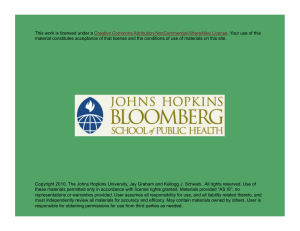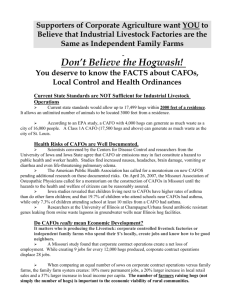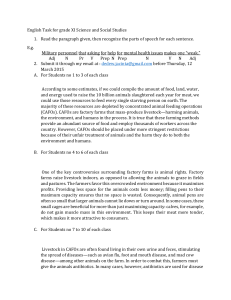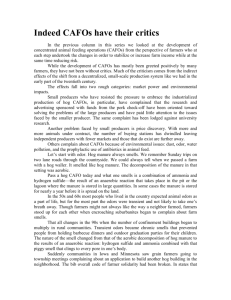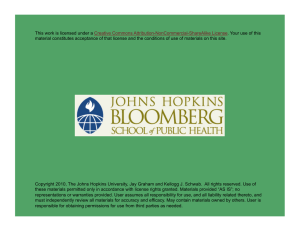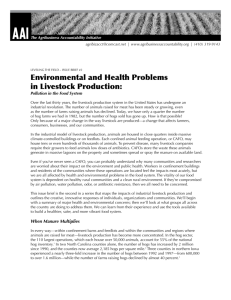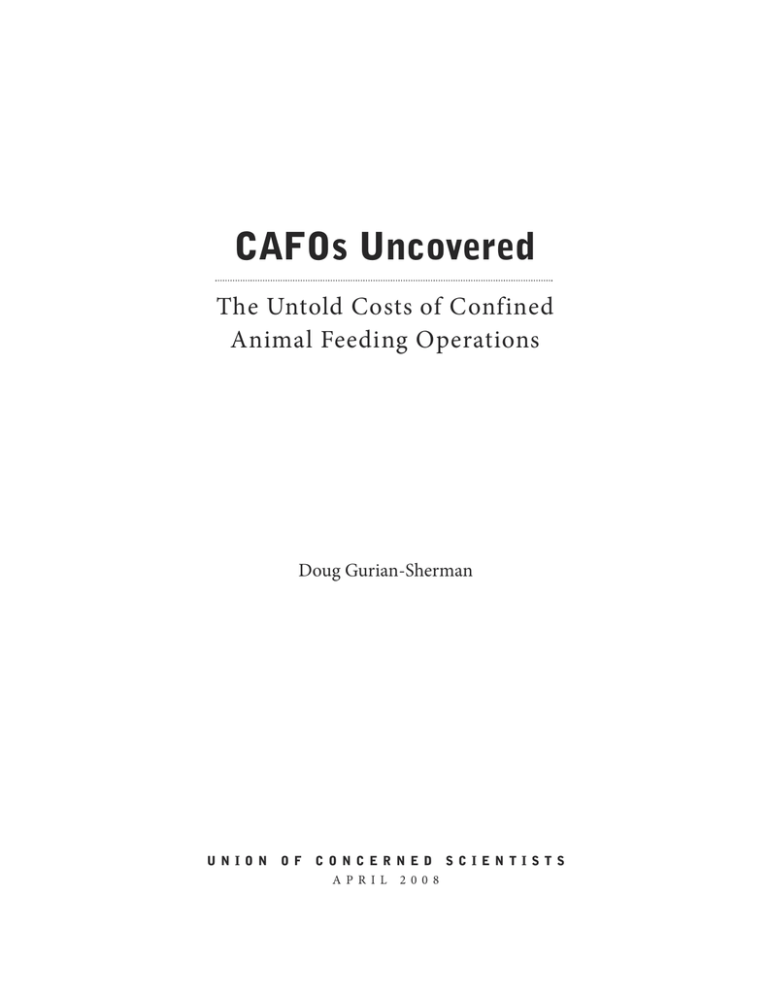
CAFOs Uncovered
The Untold Costs of Confined
Animal Feeding Operations
Doug Gurian-Sherman
U N I O N
O F
C O NC ER N E D SC I E N TI STS
A PR I L 20 0 8
ii Union of Concerned Scientists
© 2008 Union of Concerned Scientists
All rights reserved
Doug Gurian-Sherman is a senior scientist in the
Union of Concerned Scientists (UCS) Food and
Environment Program.
e Union of Concerned Scientists is the leading
science-based nonprofit working for a healthy
environment and a safer world.
e goal of the UCS Food and Environment
Program is a food system that encourages
innovative and environmentally sustainable ways
to produce high-quality, safe, and affordable food,
while ensuring that citizens have a voice in how
their food is grown.
More information about the Union of Concerned
Scientists and the Food and Environment Program
is available on the UCS website at www.ucsusa.org.
e full text of this report is available online
(in PDF format) at www.ucsusa.org or may be
obtained from:
UCS Publications
Two Brattle Square
Cambridge, MA 02238-9105
Or, email pubs@ucsusa.org or call (617) 547-5552.
COVER PHOTOS:
David Michalak, www.huntingtoncreative.com
(steak), Farmsanctuary.org (pigs),
istockphoto (money), Farmsanctuary.org (chickens) ,
Rick Dove, www.doveimaging.com and
www.neuseriver.com (fish)
DESIGN: Penny Michalak (designmz.com)
Printed on recycled paper using soy-based inks
CAFOs Uncovered
1
EXECUTIVE SUMMARY
he livestock industry (including poultry) is vital
to our national economy, supplying meat, milk,
eggs, and other animal products and providing
meaningful employment in rural communities. Until
recently, food animal production was integrated with
crop production in a balanced way that was generally beneficial to farmers and society as a whole. But
livestock production has undergone a transformation in which a small number of very large CAFOs
(confined animal feeding operations) predominate.
ese CAFOs have imposed significant—but largely
unaccounted for—costs on taxpayers and communities throughout the United States.
CAFOs are characterized by large numbers of
animals crowded into a confined space—an unnatural and unhealthy condition that concentrates too
much manure in too small an area. Many of the
costly problems caused by CAFOs can be attributed
to the storage and disposal of this manure and the
overuse of antibiotics in livestock to stave off disease.
e predominance of CAFOs is not the inevitable result of market forces; it has been fostered
by misguided public policy. Alternative production
methods can be economically efficient and technologically sophisticated, and can deliver abundant animal products while avoiding most of the problems
caused by CAFOs. However, these alternatives are at
a competitive disadvantage because CAFOs have reduced their costs through subsidies that come at the
public’s expense, including (until very recently) lowcost feed. CAFOs have also benefited from taxpayersupported pollution cleanup programs and
technological “fixes” that may be counterproductive,
such as the overuse of antibiotics. And by shiing
the risks of their production methods onto the public, CAFOs avoid the costs of the harm they cause.
T
In addition, the fact that the meat processing industry is dominated by a few large and economically
powerful companies makes it difficult for alternative
producers to slaughter their animals and get their
products to market. is excessive market concentration is facilitated by lax enforcement of laws intended to prevent anti-competitive practices.
By describing several of the subsidies and other
oen hidden costs of CAFOs that are imposed on
society (referred to as externalized costs or “externalities”), this report attempts to clarify the real
price we pay—and can no longer afford—for this
harmful system. ese externalities are associated
with the damage caused by water and air pollution
(along with cleanup and prevention), the costs
borne by rural communities (e.g., lower property
values), and the costs associated with excessive antibiotic use (e.g., harder-to-treat human diseases).
Subsidies have included payments to grain farmers
that historically supported unrealistically low animal feed prices, and payments to CAFOs to prevent
water pollution.
e United States can do better. In fact, there is
a new and growing movement among U.S. farmers
to produce food efficiently by working with nature
rather than against it. More and more meat and
dairy farmers are successfully shiing away from
massive, overcrowded CAFOs in favor of modern
production practices. We offer a number of policy
recommendations that would level the playing field
for these smart, sophisticated alternatives by reducing CAFO subsidies and requiring CAFOs to pay a
fair share of their costs.
2 Union of Concerned Scientists
CAFOs—Too Big for Our Own Good
Most of the problems caused by CAFOs result from
their excessive size and crowded conditions. CAFOs
contain at least 1,000 large animals such as beef
cows, or tens of thousands of smaller animals such
as chickens, and many are much larger—with tens
of thousands of beef cows or hogs, and hundreds of
thousands of chickens.
e problems that arise from excessive size and
density (e.g., air and water pollution from manure,
overuse of antibiotics) are exacerbated by the parallel trend of geographic concentration, whereby
CAFOs for particular types of livestock have become concentrated in certain parts of the country.
For example, large numbers of swine CAFOs are
now located in Iowa and North Carolina, dairy
CAFOs in California, and broiler chicken CAFOs in
Arkansas and Georgia.
We need to be concerned about these excessively large feeding operations because they have become the predominant means of producing meat
and dairy products in this country over the past few
decades. Although they comprise only about 5 percent of all U.S. animal operations, CAFOs now produce more than 50 percent of our food animals.
ey also produce about 65 percent of the manure
from U.S. animal operations, or about 300 million
tons per year—more than double the amount generated by this country’s entire human population. For
the purposes of this report, there are approximately
9,900 U.S. CAFOs producing hogs, dairy cows, beef
cows, broiler chickens, or laying hens.
Better Options Exist
CAFOs do not represent the only way of ensuring
the availability of food at reasonable prices. Recent
studies by the U.S. Department of Agriculture
(USDA) show that almost 40 percent of mediumsized animal feeding operations are about as costeffective as the average large hog CAFO, and many
other studies have provided similar results.
Medium-sized and smaller operations also avoid or
reduce many of the external costs that stem
from CAFOs.
If CAFOs are not appreciably more efficient
than small and mid-sized operations, why are they
supplanting smaller farms? e answers lie largely
in farm policies that have favored large operations.
CAFOs have relied on cheap inputs (water, energy,
and especially feed) to support the high animal densities that offset these operations’ high fixed costs
(such as buildings). Feed accounts for about 60 percent of the costs of producing hogs and chickens
and is also an important cost for dairy and beef
cows, and federal policies have encouraged the production of inexpensive grain that benefits CAFOs.
Perhaps even more important has been the concentration of market power in the processing industry upon which animal farmers depend. is
concentration allows meat processors to exert considerable economic control over livestock producers, oen in the form of production contracts and
animal ownership. e resulting “captive supply”
can limit market access for independent smaller
producers, since the large majority of livestock are
either owned by processors or acquired under contract—and processors typically do not contract with
smaller producers. Federal government watchdogs
have stated that the agency responsible for ensuring
that markets function properly for smaller producers is not up to the task.
Hoop barns and smart pasture operations
Although there is evidence that confinement operations smaller than CAFOs can be cost-effective and
produce ample animal products, studies also suggest
that sophisticated alternative means of producing
animal products hold even greater promise. For example, hog hoop barns, which are healthier for the
animals and much smaller than CAFOs, can produce comparable or even higher profits per unit at
close to the same price.
Research in Iowa (the major hog-producing
state) has also found that raising hogs on pasture
may produce animals at a lower cost than CAFOs.
Other studies have shown that “smart” pasture oper-
CAFOs Uncovered
ations such as managed intensive rotational grazing
(MIRG) can produce milk at a cost similar to confined dairy operations, but with added environmental benefits.
Properly managed pastures, for example, require
less maintenance and energy than the feed crops
(such as corn and soybeans) on which CAFOs rely.
Healthy pastures are also less susceptible to erosion,
can capture more heat-trapping carbon dioxide than
feed crops, and absorb more of the nutrients applied
to them, thereby contributing less to water pollution. Furthermore, the manure deposited by animals
onto pasture produces about six to nine times less
volatilized ammonia—an important air pollutant—
than surface-applied manure from CAFOs.
The Many Hidden Costs of CAFOs
Feed grain subsidies
CAFOs have been indirectly supported by huge taxpayer-funded subsidies that compensated grain
farmers for excessively low prices. Because feed
makes up such a large part of CAFOs’ costs, lower
grain prices can have a big impact on the total cost
of production.
Over the past few decades, federal farm bills
have progressively moved toward policies that let
grain prices fall—oen below the cost of production—and compensated farmers for much of the
difference. Without such subsidies, grain farmers
would not have been able to continue selling their
product at such low prices, which benefit CAFOs.
is so-called indirect subsidy to hog and
broiler CAFOs amounts to hundreds of millions of
dollars per year. When extended to include the
dairy, beef, and egg sectors, low-cost grain was
worth a total of almost $35 billion to CAFOs from
1996 to 2005, or almost $4 billion per year.
Farms that raise animals on pasture and those
that grow their own grain do not usually receive as
much of a subsidy as the CAFO industry. Pastures
themselves are not subsidized at all, so the sustenance that livestock derive from pastures receives
no government support.
3
During the past few years, grain prices have approached or even risen above the cost of production. Under these conditions, CAFOs no longer
benefit from grain subsidies, but the problem of increasing concentration in the processing industry
persists. is may make it difficult for CAFO alternatives to gain substantial market share without
changes in U.S. policy.
Pollution prevention subsidies
Another farm bill program, the Environmental
Quality Incentives Program (EQIP), provides
CAFOs with another important subsidy. Beginning
in 2002, CAFOs were no longer explicitly excluded
from EQIP funding (which was originally intended
to help smaller farming operations reduce their pollution), and the maximum funding level for individual projects has increased dramatically to $450,000.
Several criteria used to prioritize projects such as
manure disposal actually favor CAFOs over pasturebased operations. Extrapolation from the available
data suggests that U.S. CAFOs may have benefited
from about $125 million in EQIP subsidies in 2007.
State-level EQIP projects can also favor confinement operations. California, the state with the most
dairy CAFOs, spends $10 million of its allocated
EQIP subsidies each year to address dairy manure
issues. Georgia, the state with the most broiler
chicken CAFOs, uses EQIP funds to support the
transportation of chicken manure from that part of
the state where broiler CAFOs are primarily located
to areas with enough cropland to accept this manure. e distance involved would oen not be economically feasible without subsidization.
Water pollution from manure
Disposal of CAFO manure on an insufficient
amount of land results in the runoff and leaching of
waste into surface and groundwater, which has contaminated drinking water in many rural areas, and
the volatilization of ammonia (i.e., the transfer of
this substance from manure into the atmosphere).
Several manure lagoons have also experienced catastrophic failures, sending tens of millions of gallons
4 Union of Concerned Scientists
of raw manure into streams and estuaries and killing
millions of fish. Smaller but more numerous spills
cause substantial losses as well.
Remediation of the leaching under dairy and
hog CAFOs in Kansas has been projected to cost
taxpayers $56 million—and Kansas is not one of the
country’s top dairy- or hog-producing states. Based
on these data, a rough estimate of the total cost of
cleaning up the soil under U.S. hog and dairy
CAFOs could approach $4.1 billion.
The two primary pollutants from manure, nitrogen and phosphorus, can cause eutrophication
(the proliferation and subsequent death of aquatic
plant life that robs freshwater and marine environments of the oxygen that fish and many other
aquatic organisms need to survive). For example,
runoff and leaching from animal sources including
CAFOs is believed to contribute about 15 percent
of the nutrient pollution that reaches the Gulf of
Mexico, where a large “dead zone”—devoid of fish
and commercially important seafood such as
shrimp—has developed. CAFO manure also contributes to similar dead zones in the Chesapeake
Bay (another important source of fish and shellfish) and other important estuaries along the East
Coast. The Chesapeake Bay’s blue crab industry,
which had a dockside value of about $52 million in
2002, has declined drastically in recent years along
with other important catches such as striped bass,
partly due to the decline in water quality caused in
part by CAFOs.
Although it is difficult to account for all of the
social benefits (such as fisheries and drinking
water) lost due to CAFO pollution, it is reasonable
to assume the losses are substantial. One indirect
way of estimating such costs is to calculate the cost
of preventing some or all of the pollution caused
by CAFOs. The USDA, for example, has determined how much it would cost to transport manure to enough crop fields or pastures to comply
with new Clean Water Act rules governing the distribution of manure on fields. Based on a nitrogenlimited standard and realistic estimates of the rate
at which farms will accept manure, the annual cost
of adequate manure distribution in the Chesapeake
Bay region alone would total $134 million per year.
Using a phosphorus-limited standard and an unrealistically high manure acceptance rate, the cost
would be $153 million annually. Considering that
net returns for the animal industry in this region
amount to $313 million, compliance with such
standards could comprise between 43 and 49 percent of net returns.
Air pollution from manure
Airborne ammonia is a respiratory irritant and can
combine with other air pollutants to form fine particulate matter that can cause respiratory disease.
And because ammonia is also re-deposited onto the
ground, mostly within the region from which it
originates, ammonia nitrogen deposited on soils
that have evolved under low-nitrogen conditions
may reduce biodiversity and find its way into water
sources. Ammonium ion deposition also contributes to the acidification of some forest soils.
Animal agriculture is the major contributor of
ammonia to the atmosphere, and the substantial
majority of this ammonia likely comes from confinement operations, since manure deposited by
livestock on pasture contributes proportionately
much less ammonia to the atmosphere than manure
from CAFOs. Up to 70 percent of the nitrogen in
CAFO manure can be lost to the atmosphere depending on manure storage and field application
measures. Over the past several decades, the
amount of airborne ammonia deposition in many
areas of the United States with large numbers of
CAFOs has been rising dramatically, and may oen
exceed the capacity of forests and other environments to utilize it without harm.
e USDA has estimated the total U.S. cost of
controlling air and water pollution through manure
distribution onto farmland—in quantities that comply with the Clean Water Act—at $1.16 billion per
year under high manure acceptance rates. However,
the standard applied in this calculation would only
reduce airborne ammonia pollution from CAFOs by
about 40 percent. And if lower, more realistic ma-
CAFOs Uncovered
nure acceptance rates were used, the manure would
have to be transported unacceptable distances.
erefore, proper manure disposal from CAFOs at
current farmer acceptance rates would in all likelihood exceed these values considerably.
Harm to rural communities
CAFOs are sited in rural communities that bear the
brunt of the harm caused by CAFOs. is harm includes the frequent presence of foul odors and water
contaminated by nitrogen and pathogens, as well
as higher rates of respiratory and other diseases
compared with rural areas that are not located
near CAFOs.
One study determined that each CAFO in Missouri has lowered property values in its surrounding
communities by an average total of $2.68 million. It
is not possible to accurately extrapolate this value
nationally due to the many differences between localities, but as a very rough indication of the magnitude of these costs, multiplying by 9,900 (the total
number of U.S. CAFOs as defined for this report)
would yield a loss of about $26 billion.
Antibiotic-resistant pathogens
Estimates have suggested that considerably greater
amounts of antibiotics are used for livestock production than for the treatment of human disease in
the United States. e massive use of antibiotics in
CAFOs, especially for non-therapeutic purposes
such as growth promotion, contributes to the development of antibiotic-resistant pathogens that are
more difficult to treat.
Many of the bacteria found on livestock (such as
Salmonella, Escherichia coli, and Campylobacter) can
cause food-borne diseases in humans. Furthermore,
recent evidence strongly suggests that some methicillin-resistant Staphylococcus aureus (MRSA) and
uropathogenic E. coli infections may also be caused
by animal sources. ese pathogens collectively
cause tens of millions of infections and many thousands of hospitalizations and deaths every year.
e costs associated with Salmonella alone have
been estimated at about $2.5 billion per year—about
5
88 percent of which is related to premature deaths.
Because an appreciable degree of antibiotic resistance in animal-associated pathogens is likely due to
the overuse of antibiotics in CAFOs, the resulting
costs are likely to be high. Eliminating the use of antibiotics for growth promotion (the majority of
which occurs on CAFOs) could cost CAFOs
between $1.5 billion and $3 billion per year.
Conclusions and Recommendations
e costs we pay as a society to support CAFOs—in
the form of taxpayer subsidies, pollution, harm to
rural communities, and poorer public health—is
much too high (Table ES-1, p. 6). For example, conservative estimates of grain subsidies and manure
distribution alone suggest that CAFOs would have
incurred at least $5 billion in extra production costs
per year if these expenses were not shied onto the
public. e figure would undoubtedly be much
higher if truly adequate manure distribution was required. Although we do not have good national data
for other costs quantified in Table ES-1, and some
that have not been quantified (such as water and energy use and water purification costs), they could
amount to billions of dollars more per year.
Technological solutions to specific CAFO problems have been proposed, such as feed formulations
that would reduce manure nitrogen, lagoon covers
that would reduce atmospheric ammonia, and “biogas” capture and production that would reduce
methane emissions from manure, but these are only
partial solutions and would generally add to the cost
of production. None of these technologies solve antibiotic resistance, loss of rural income, or the
ethical treatment of animals. By comparison, sophisticated CAFO alternatives can provide plentiful
animal products at similar prices, but with much
fewer of the problems caused by CAFOs.
e bottom line is that society is currently propping up an undesirable form of animal agriculture
with enormous subsidies and a lack of accountability for its externalized costs. Once we appreciate the
role these subsidies—along with government
6 Union of Concerned Scientists
Table ES-1. CAFO Costs Underwritten by U.S. Taxpayers1
Cost of Pollution or
Pollution Avoidance
Cost to Distribute and
Apply Manure to Fields
$1.16 billion/year2
Reduction in Property Values
$26 billion (total loss)3
Public Health Costs from Overuse
of Antibiotics in Livestock
$1.5 billion – $3.0 billion/year4
Remediation of Leakage from
Manure Storage Facilities
(Swine and Dairy)
$4.1 billion (total cost)5
Cost of Subsidy
Grain Subsidies for Livestock Feed
$3.86 billion/year6
EQIP Subsidy
$100 million – $125 million7
1
Numbers are rough estimates of current or recent costs and are presented only to indicate the magnitude of these costs. See the text for details.
SOURCE: Aillery et al. 2005.
SOURCE: Mubarak, Johnson, and Miller 1999. Extrapolation from Missouri data based on national CAFO numbers.
4 SOURCE: NRC 1999. Extrapolation based on U.S. population of 300 million.
5 SOURCE: Volland, Zupancic, and Chappelle 2003. Extrapolation from Kansas data based on national swine and dairy CAFO numbers.
6 SOURCE: Starmer 2007. Data averaged over the period 1996–2005.
7 SOURCE: NRCS 2003. Calculations based on NRCS projections for 2007 (yearly values increase from a low in 2002 to a high in 2007).
2
3
policies—play in shaping the way our food animals
are raised, we can also see the environmental,
health, and economic benefits to be gained from
redirecting agriculture toward smart pasture operations and other desirable alternatives.
Public policies that support CAFOs at the expense of such alternatives should be eliminated, and
policies that support these alternatives should be
implemented. Needed actions include:
• Strict and vigorous enforcement of antitrust and
anti-competitive practice laws under the Packers
and Stockyards Act (which cover captive supply,
transparency of contracts, and access to open
markets)
• Strong enforcement of the Clean Water Act as it
pertains to CAFOs, including improved oversight at the state level or the takeover of responsibilities currently delegated to the states for
approving and monitoring and enforcement of
National Pollution Discharge Elimination System (NPDES) permits; improvements could include more inspectors and inspections, better
monitoring of manure-handling practices, and
measurement of pollution prevention practices
• Development of new regulations under the
Clean Air Act that would reduce emissions of
ammonia and other air pollutants from CAFOs,
and ensure that CAFO operators cannot avoid
such regulations by encouraging ammonia
volatilization
• Continued monitoring and reporting of ammonia and hydrogen sulfide emissions as required
under the Comprehensive Environmental Response, Compensation, and Liability Act
(CERCLA, commonly referred to as the “Superfund”) and the Emergency Planning and
Community Right-to-Know Act (EPCRA)
• Replacement of farm bill commodity crop subsidies with subsidies that strengthen conservation programs and support prices when supplies
are high (rather than allowing prices to fall
below the cost of production)
• Reduction of the current $450,000 EQIP project cap
to levels appropriate to smaller farms, with a focus
on support for sound animal farming practices
• Revision of slaughterhouse regulations to facilitate larger numbers of smaller processors, including the elimination of requirements not
CAFOs Uncovered
appropriate to smaller facilities, combined with
public health measures such as providing adequate numbers of federal inspectors or empowering and training state inspectors
• Substantial funding for research to improve
alternative animal production methods (especially
pasture-based) that are beneficial to the environment, public health, and rural communities
7

